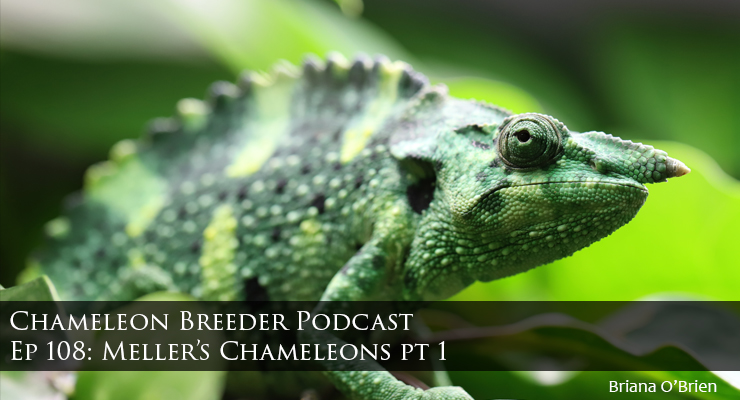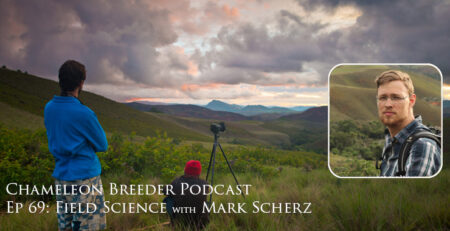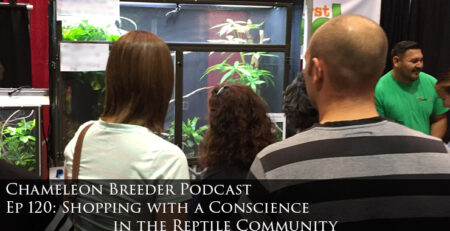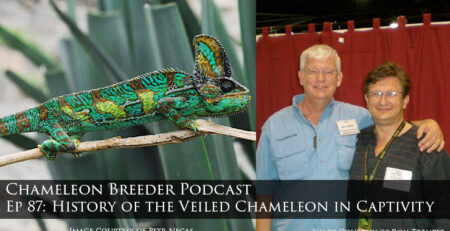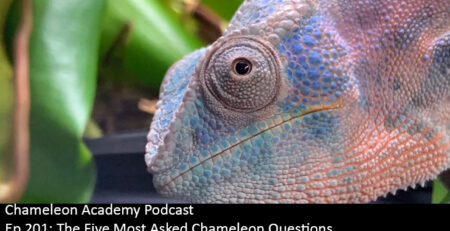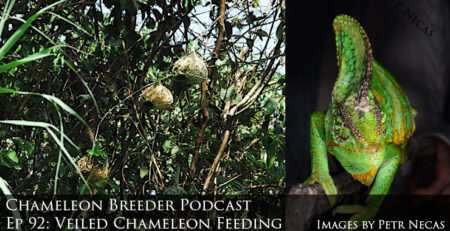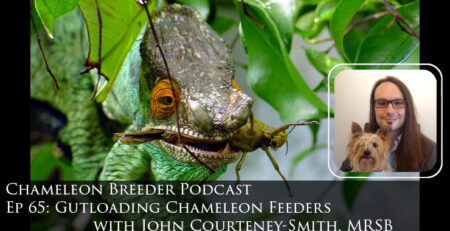Ep 108 Meller’s Chameleons Part 1
One of the most impressive of chameleons is the Meller’s Chameleon. Trioceros melleri is the largest of the African chameleons. With recent captive hatched specimens available in the US, Canada, and Europe more keepers have access to this special species. But there are extra preparations necessary to keep them healthy. Today I start the discussion with the top breeders of Trioceros melleri who have graciously agreed to share with you their methods for success.
Introduction to this Podcast Episode
Welcome to a special episode of the Chameleon Breeder Podcast. Today I have the pleasure of presenting the first of a two part series on Trioceros melleri, the Meller’s Chameleon. This series is especially relevant today as the breeders you will meet are making captive hatched and raised babies available for a new generation of keepers to join the effort to establish this species in captivity.
It is my hope that this series will both warn and inspire you. And if you are in a position to have a baby melleri join your household then you are in for a unique experience!
Often when I am interviewing a breeder only one of the many countries is able to have access to the captive raised babies. This time, I am pleased to have on breeders from the US, Canada, and the UK.

Dale Tamura lives in California, USA.
Dale had an interesting introduction to chameleons as he started with a Meller’s Chameleon given to him as a gift from his family. He fell in love with this chameleon and dedicated himself to providing for him and other melleri that would soon join. Dale currently maintains a colony of these magnificent chameleons at his business where he houses them in museum-like display cages which sets the bar as to what a chameleon set-up can look like.
In 2018, Dale produced his first captive hatched babies and repeated the success in 2019. He has unrelated bloodlines and is continuing his momentum towards the goal of producing a generation of F2 Meller’s Chameleons.
If you are interested in inquiring about becoming a new Melleri home you may contact Dale on his Facebook page at Dale Tamura Facebook

Martine Desjardins lives in Quebec, Canada.
Martine got her start with reptiles while babysitting an iguana. It wasn’t until she met a chameleon that she knew she had found her calling. After a heartbreaking start attempting to rehabilitate an imported Meller’s Chameleon she vowed to make captive hatched babies available to her home country of Canada.
Martine has refined the concept of the free range set-up to match the needs of the Meller’s Chameleon. Though she recommends against doing a group in a free range like she does (due to cost, time, and skill to maintain it properly) we can learn a tremendous amount from her experiences.

James Killey lives in the United Kingdom.
James has been a long time chameleon breeder and restarted his work with Trioceros melleri when his girlfriend brought home a pair to surprise him. James started them off as a pair in a large cage, but then went with his gut instinct that things could be better. After separating them he was able to get strong mating behavior which resulted in successful reproduction.
James works with the Rothwell Pets and Reptiles store in Rothwell, UK, though he mentions that he is picky about who he sells a chameleon to and the average pet store customer is not a suitable candidate. His chameleon customers are generally by personal contacts and the Hamm show.
Natural History of Trioceros Melleri
Trioceros melleri, the Meller’s Chameleon is the largest African chameleon. According to C. Tillbury, this chameleon was named after Dr. Charles James Meller who produced the holotype as he travelled with Livingstone as a surgeon and botanist.
Trioceros melleri can reach up to 24” inches and is found in lower elevations from sea level up to about 800 meters. It is endemic to the coast side of Tanzania and areas in Mozambique and Malawi. The weather conditions across the range can vary so it is reasonable for those interested in recreating their natural conditions to be aware of the origin of their chameleons. Tanzanian T. melleri have wet season highs up to 90 to low 70s at night and dry season fluctuations from the low 80s to the low 60s
Malawi T. melleri have wet season high up to the mid 80s to high 60s and dry season fluctuations from mid 70s to high 50s.
Due to the proximity to the equator, the natural range receives about 12 hours sunlight and 12 hours nighttime with a seasonal variation of about one hour longer and shorter. Though, as a note, they are south of the equator so the longest day, at 13 hours is in December.
In their natural range they receive a wide seasonal variation with a wet season from October through May with a dry season taking the rest of the year.
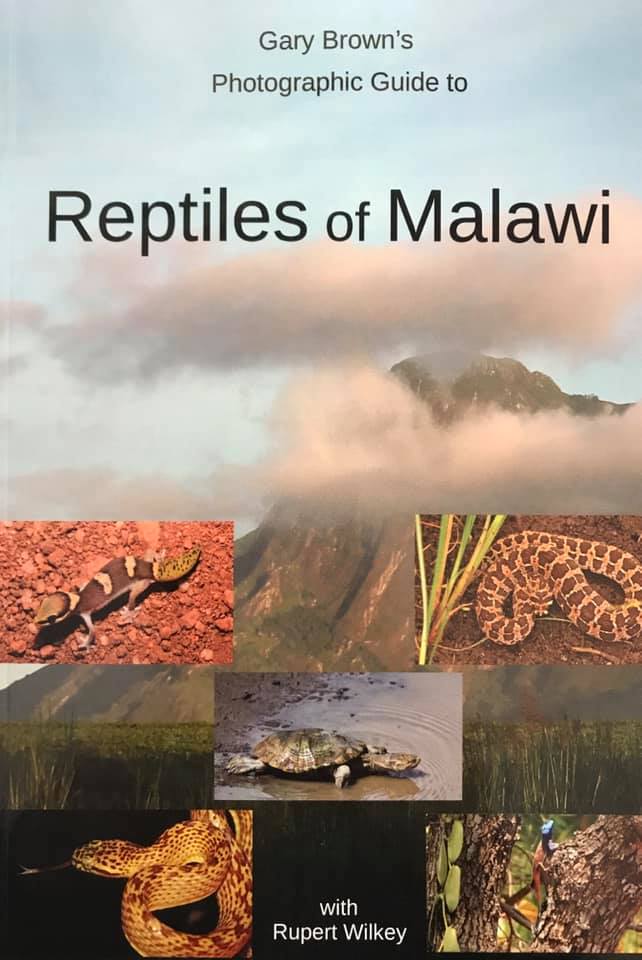
Gary Brown, a herpetologist in Malawi and the author of Reptiles of Malawi shared his observations of natural T. melleri in a written interview
Bill: What kind of natural behaviors do Trioceros melleri show in the wild?
Gary: During the rainy season, the males head off looking for females, and the females head off looking for suitable locations to lay eggs, so in cities like Blantyre, where there are many, they are often found crossing the roads, in the rainy season
Bill: How can something so large hide so well?
Gary: “It doesn’t take much to disappear in the tops of the trees, and they have a habit of moving around the branch, to put it between them and you, so you cant see them. They have amazing eye sight, and can see danger from a good way off.”
Bill: And finally, what is their social structure?
Gary: “I have often seen them sharing trees, but not close together. ”
If you are interested in learning about the Meller’s Chameleon and the other reptiles of Malawi there is a limited print run of Gary’s book “The Reptiles of Malawi” available through Njoka Books in the UK. Click here to place an order.
Njoka Books
Dale Tamura's Cage Banks

Dale Tamura creates museum quality caging and keeps one chameleon per cage.
Martine's Free Range

The reason why Martine’s free range works is that it is large enough to give every inhabitant a separate areas with basking lights and regular watering. With nothing to lack there is no reason to wander.
There is also a great deal of space between territories allowing the inhabitants to feel secure.

